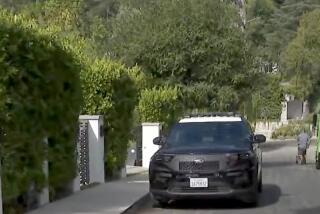RIOT AFTERMATH : Oakwood Violence Targets Symbols of Gentrification
VENICE — The rioting that engulfed parts of Los Angeles last week leaped across town to the Oakwood section of Venice, leaving a trail of smashed windows, looted stores and renewed tension over gentrification, an issue that stirs up the racially mixed community.
The property damage was minimal compared with other hot spots in the region, although by the weekend National Guard patrols had moved in with armored vehicles to bolster local police. Beatings were few, no one was reported killed, and looting was limited mostly to a stretch of Lincoln Boulevard, police said.
But the destruction that hit residences--broken windows and doors and a mob-set fire that destroyed an Indiana Avenue apartment--followed a grim logic missing from other places: To many black residents, the targets were infuriating symbols of wealthy white encroachment into an area plagued by poverty, drug violence and a feeling of official neglect, if not antipathy.
“Those young brothers don’t have no jobs. They don’t have no hope. They don’t have no training. So this is what they did--they rebelled,” said Melvyn Hayward Sr., a youth counselor and resident manager of one of the 14 federally subsidized Holiday Venice apartment buildings in the neighborhood. “Most of those people that they hit . . . They symbolize the rich. They symbolize the haves. And all the people who did it--they’re the have-nots. The eyesore.”
Hayward said that, in the end, older members of the Shoreline Crips persuaded younger hotheads not to carry the violence beyond several blocks at the gentrifying western edge of Oakwood. “The Crips, they’re the ones that saved the community from what could have happened,” he said.
Police Lt. George Ibarra said police suspected that the vandalism was gang retaliation against residents--white and black--who had cooperated with authorities in trying to stem rampant drug-dealing, but he could not say who was involved.
While there was relative calm throughout the community this week, anger remained evident.
“We’re still real mad,” a gang member told a reporter outside one of the apartments Monday. “If you don’t want to get injured, you better get out of here.”
The tension underlying last week’s disturbances in Oakwood is nothing new to the community of 9,200, which until 20 years ago was predominantly black but is now about half Latino. Whites make up about one-fourth of the population and blacks about one-fifth.
Among many older residents, longstanding mistrust of the police and the newcomers drawn by a funky, beach-town appeal and affordability has sprouted fears that a conspiracy exists to push poorer blacks out. Officials have dismissed those fears as absurd.
For liberal white residents who pride themselves on living in a racially diverse community, the attacks have bred fear and confusion. Several tenants of buildings that were struck--including the torched apartment--cleared out for good. Property owners already were planning stepped-up security measures. One Indiana Avenue resident said that after nearly four years of living there, he had acquired a gun.
The paradox of the recent events was summed up in the message painted on the Venice-Ocean Park Food Co-Op: “Black, White & Latino Owned.” It was painted on the plywood that covered store windows.
Most Oakwood residents were crossing their fingers that the violence was over--and wondering how to bridge the apparent gaps.
“I don’t want to be hopeless and I don’t want to be helpless. And I’m a little of both right now,” said David Schoeff, the white owner of an unfinished three-unit condominium project on Indiana Avenue that was vandalized last Wednesday. Schoeff said he had contacted the office of Councilwoman Ruth Galanter on Tuesday in an effort to identify key black community leaders with whom to talk.
At Sunday’s service in the New Bethel Baptist Church on Brooks Avenue only doors away from damaged homes, the Rev. Marvis Davis urged parishioners to mine community renewal and racial peace from the ruins, even as he noted that “pots were boiling” long before the Rodney G. King verdicts.
Victor Campbell, a black worshiper currently off work due to disability, said the gentrifying edges of Oakwood have served as reminders of the life that people there cannot afford, though he strongly condemned the violence.
“A lot of people in the community have been angry because it’s hard for young people to find jobs,” he said. “A lot of people here are poor. They can’t afford to pay $1,000 a month for rent.”
More to Read
Sign up for Essential California
The most important California stories and recommendations in your inbox every morning.
You may occasionally receive promotional content from the Los Angeles Times.









